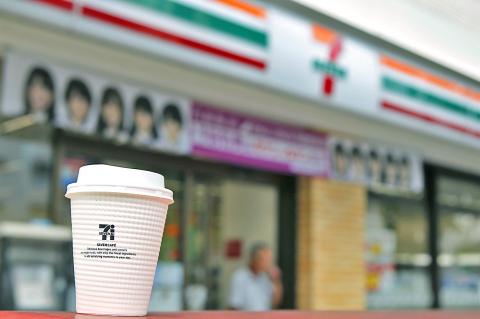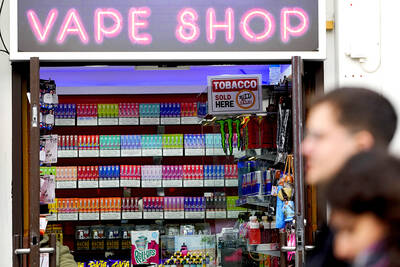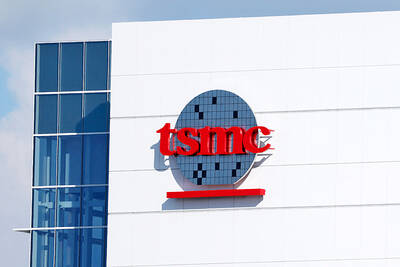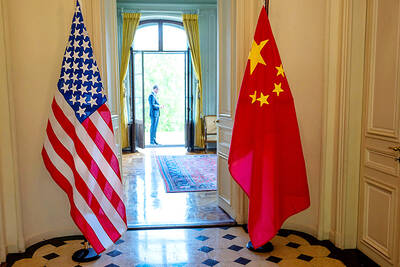The fastest-growing drinks market in Japan is not craft beer or fruit smoothies, it is US$1 cups of black coffee from the local 7-Eleven.
“Convenience-store coffee is just great, given its low price,” said Kiyoshi Fujimoto, a 50-year-old school teacher in Tokyo.
He estimates he drinks coffee from the shops locally known as conbinis four times as often as from Starbucks Corp and pays about one-third of the price.

Photo: Bloomberg
Coffee sales at convenience stores surged 48 percent last year, the fastest-growing part of Japan’s beverage market, as US$1-a-cup brews boosted consumption to a record.
Japan is the world’s biggest coffee importer after the US and Germany. Demand per person will eventually be comparable to the US and Europe, said Kazuyuki Kajiwara, general manager at the beverage department of trading company Marubeni Corp.
Bean and product imports reached 459,708 tonnes last year, according to roasters’ group the All Japan Coffee Association. The biggest suppliers are Brazil, Vietnam and Colombia, government data showed.
Consumption was an all-time high 449,908 tonnes last year, the coffee association said.
Convenience store chain 7-Eleven, which operates 17,600 stores nationwide, plans to boost sales by 21 percent to 850 million cups for the year through February, company director Yasushi Kamata said.
FamilyMart Co, the third-biggest Japanese operator of convenience stores, aims to bolster brewed coffee sales 11 percent, spokeswoman Natsu Takaoka said.
Starbucks opened in Japan in 1996, its first market outside North America, and now operates 1,100 stores across the nation, James Olson, a spokesman for the Seattle-based company, said in an e-mail.
Japanese stores are among its most profitable, he said.
Starbucks does not disclose how much coffee it purchases or sells in Japan, Olson said.
Tully’s Coffee, also based in Seattle, has 588 stores in Japan, according to the company’s Web site.
About 10 percent of Japan’s bean imports supply convenience stores, with 7-Eleven representing about half of that volume, Kajiwara said.
Lawson Inc, Japan’s second-biggest operator of convenience stores, also brews coffee for sale at ¥100 (US$0.80) a cup, the same as 7-Eleven and FamilyMart.
“Salarymen and housewives are saying that coffees at Starbucks” and other chain cafes are too expensive to buy everyday, Lawson merchandising division deputy director Akio Yoshizawa said.
Japan’s coffee demand is expected to grow by about 2 percent annually, said Kajiwara, whose firm imports beans for 7-Eleven. Per-capita consumption is set to expand to 5kg a year from 3.5kg, he said.
“In my office, only instant coffee is available,” said Kiyoshi Fujimoto, a teacher in Tokyo. ‘When I want to have a good coffee, I escape from the school to get it at a convenience store.’’
Coffee brewed by the stores expanded 48 percent last year and sales are set to increase 17.3 percent to ¥175.9 billion this year, according to Fuji Keizai, a research group in Tokyo.
Japan’s total beverage market shrank 1.5 percent to ¥4.98 trillion last year, the researcher said in a report in May.
It is not just demand for freshly brewed coffee that is increasing. About 100,000 tonnes of Japan’s total coffee imports were used for production of instant coffee and a similar amount was used to make canned coffee, Kajiwara said.
Coca-Cola Co’s Japanese unit and Suntory Beverage & Food Ltd are the biggest makers of ready-to-drink canned coffee, sold mainly through vending machines.
“Convenience stores have created additional demand,” Kajiwara said. “They are selling above-average coffee at the cheapest price in the world.”

Real estate agent and property developer JSL Construction & Development Co (愛山林) led the average compensation rankings among companies listed on the Taiwan Stock Exchange (TWSE) last year, while contract chipmaker Taiwan Semiconductor Manufacturing Co (TSMC, 台積電) finished 14th. JSL Construction paid its employees total average compensation of NT$4.78 million (US$159,701), down 13.5 percent from a year earlier, but still ahead of the most profitable listed tech giants, including TSMC, TWSE data showed. Last year, the average compensation (which includes salary, overtime, bonuses and allowances) paid by TSMC rose 21.6 percent to reach about NT$3.33 million, lifting its ranking by 10 notches

Popular vape brands such as Geek Bar might get more expensive in the US — if you can find them at all. Shipments of vapes from China to the US ground to a near halt last month from a year ago, official data showed, hit by US President Donald Trump’s tariffs and a crackdown on unauthorized e-cigarettes in the world’s biggest market for smoking alternatives. That includes Geek Bar, a brand of flavored vapes that is not authorized to sell in the US, but which had been widely available due to porous import controls. One retailer, who asked not to be named, because

SEASONAL WEAKNESS: The combined revenue of the top 10 foundries fell 5.4%, but rush orders and China’s subsidies partially offset slowing demand Taiwan Semiconductor Manufacturing Co (TSMC, 台積電) further solidified its dominance in the global wafer foundry business in the first quarter of this year, remaining far ahead of its closest rival, Samsung Electronics Co, TrendForce Corp (集邦科技) said yesterday. TSMC posted US$25.52 billion in sales in the January-to-March period, down 5 percent from the previous quarter, but its market share rose from 67.1 percent the previous quarter to 67.6 percent, TrendForce said in a report. While smartphone-related wafer shipments declined in the first quarter due to seasonal factors, solid demand for artificial intelligence (AI) and high-performance computing (HPC) devices and urgent TV-related orders

MINERAL DIPLOMACY: The Chinese commerce ministry said it approved applications for the export of rare earths in a move that could help ease US-China trade tensions Chinese Vice Premier He Lifeng (何立峰) is today to meet a US delegation for talks in the UK, Beijing announced on Saturday amid a fragile truce in the trade dispute between the two powers. He is to visit the UK from yesterday to Friday at the invitation of the British government, the Chinese Ministry of Foreign Affairs said in a statement. He and US representatives are to cochair the first meeting of the US-China economic and trade consultation mechanism, it said. US President Donald Trump on Friday announced that a new round of trade talks with China would start in London beginning today,